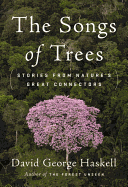
The essays in The Songs of Trees by David Haskell are contemplative, lyrical and filled with insights on nature that come from years of dedicated observation. Haskell has a deep understanding of the complexities of nature and the interconnectedness of living things. These relationships can be seen through the interactions of a variety of trees around the globe with the birds, insects, animals, air, water and soil that surround them. His descriptions at times are like eulogies to dying trees that have fallen due to an encroaching sea, and at other times akin to the notes an oenologist might write for a fine wine: "The golden sap between dark plates of ponderosa bark has the vigorous odor of rosin and turpentine: oily, acidic, and bright."
Haskell studies the various microcosmic layers of plants, insects and water among the branches and leaves of a giant ceibo tree deep in the Amazon jungle. He listens to the rain as it falls on orchids, bromeliads, strangler figs and philodendron leaves, and hears hundreds of bats, the croak of frogs, the squawk of scarlet macaws and the call of howler monkeys from upper branches where the energy is vibratory and intense.
Throughout his observations, he deftly interweaves a deeper and broader scope: history, war, climate change, industrialization--the latter of which is threatening not just to these trees, but to all living things that share this planet. If anyone ever doubted that life is dependent on symbiotic relationships, then reading Haskell's The Songs of Trees will change that opinion forever. --Lee E. Cart, freelance writer and book reviewer

